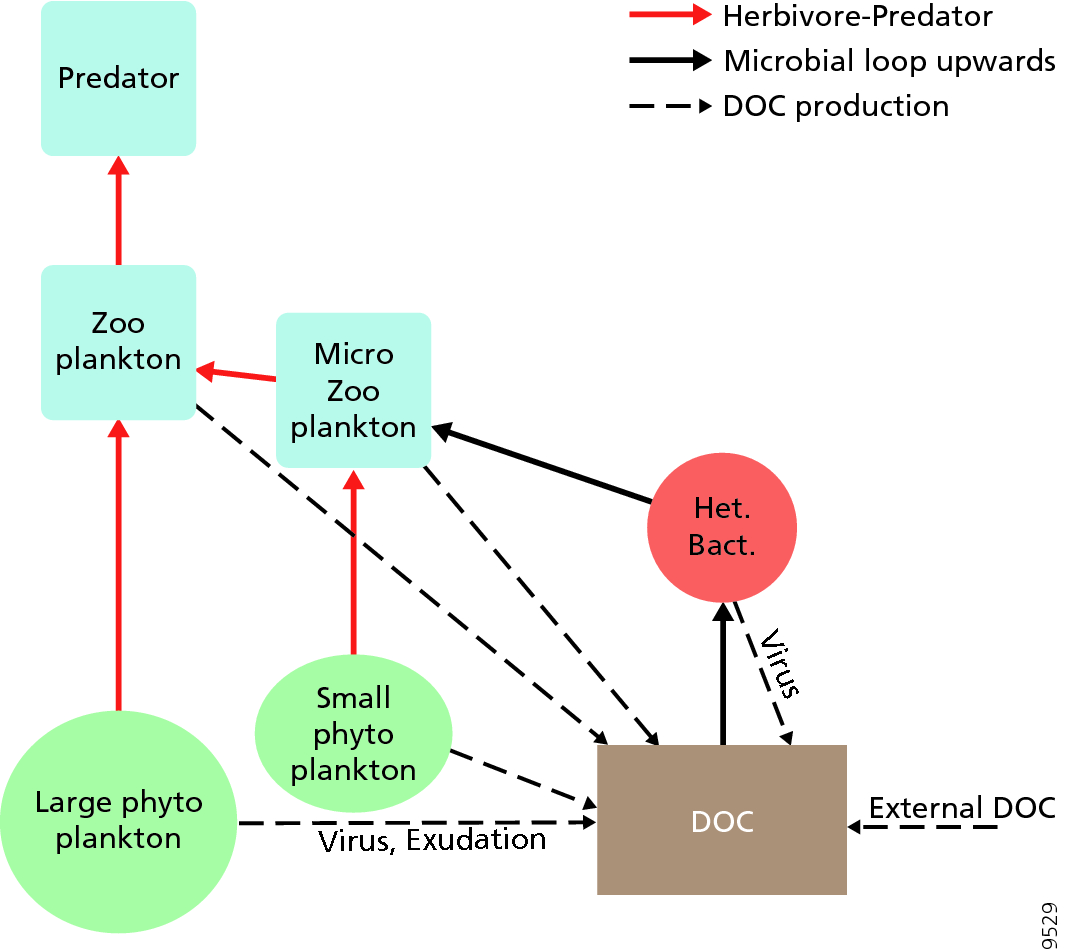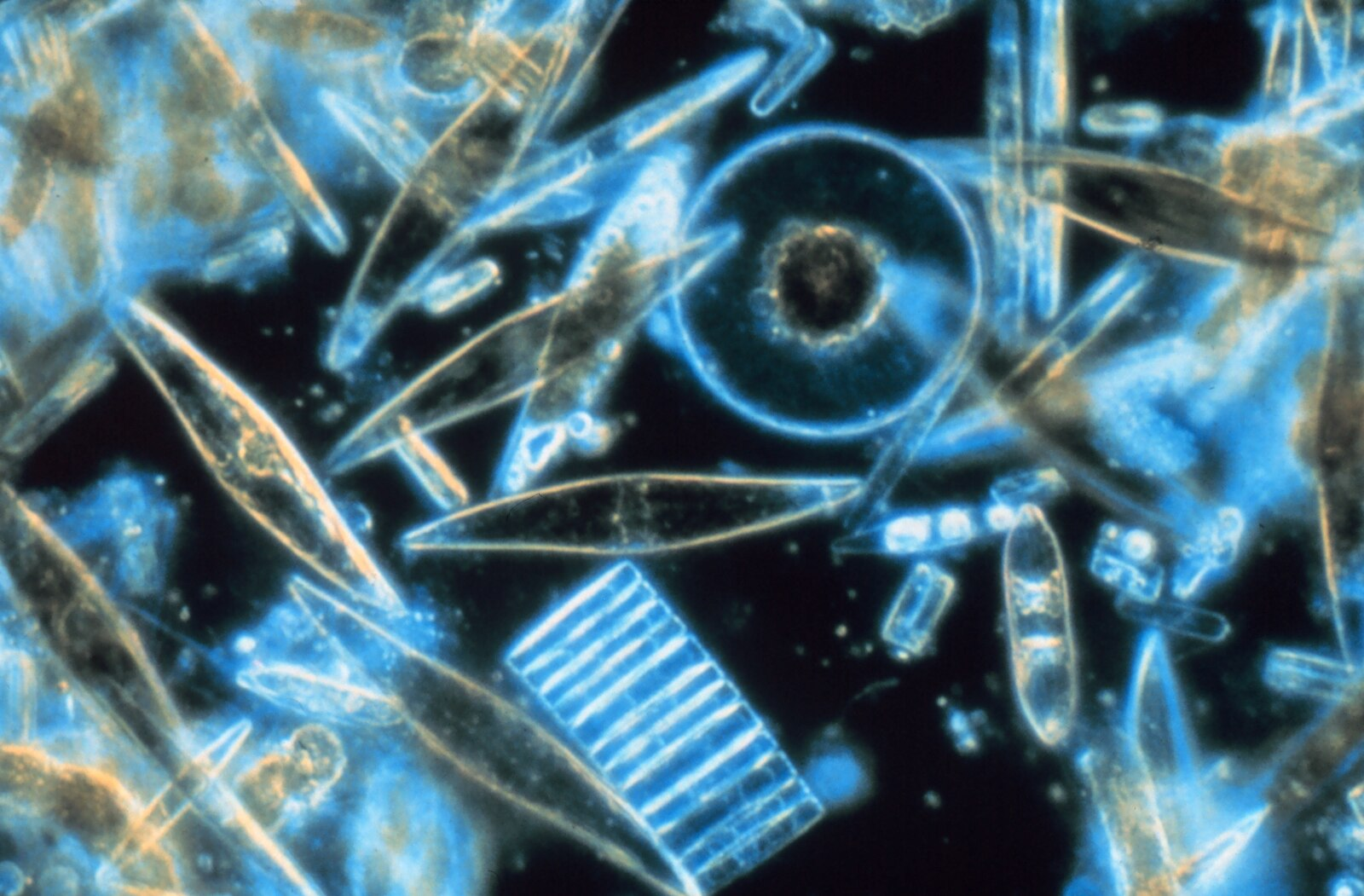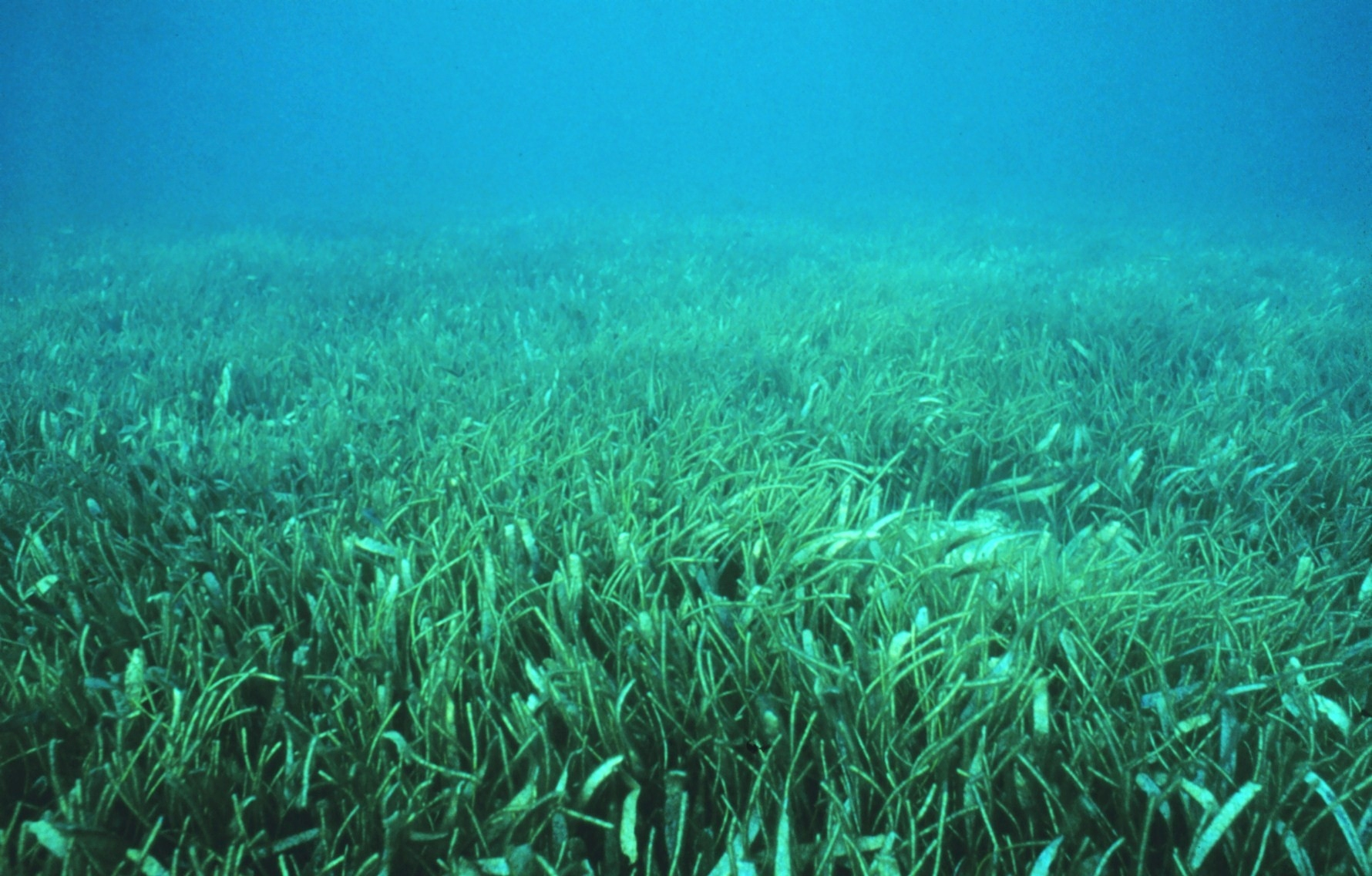IB Syllabus focus:
‘Phytoplankton and macrophytes capture energy for freshwater and marine food webs.’
Primary producers form the essential base of aquatic ecosystems by converting sunlight into usable energy through photosynthesis. They sustain food webs in both freshwater and marine environments.

Diagram of food‐web structure in the euphotic (sunlit) zone, with phytoplankton at the base, energy transfer to zooplankton and predators, and recycling pathways. The figure includes the “microbial loop,” which is useful context but more detailed than required by the syllabus. Source.
Primary Producers in Aquatic Ecosystems
The Role of Primary Producers
Primary producers are organisms that synthesise their own food using solar energy and inorganic substances. In aquatic ecosystems, these producers are mainly phytoplankton and macrophytes.
Primary Producers: Organisms that generate organic matter from inorganic sources through photosynthesis, forming the base of food webs.
These producers support all higher trophic levels, from small invertebrates to large predators like fish, marine mammals, and seabirds.
Phytoplankton: Microscopic Producers
Characteristics of Phytoplankton
Microscopic algae that drift in the water column.
Extremely abundant and responsible for about half of the Earth’s photosynthetic activity.
Include diverse groups such as diatoms, dinoflagellates, and cyanobacteria.

Assorted diatoms viewed through a microscope, illustrating silica cell walls and diverse forms typical of phytoplankton. This real-world visual complements the definition of phytoplankton given in the notes. Source.
Phytoplankton: Microscopic photosynthetic organisms that float in aquatic environments and form the foundation of marine and freshwater food webs.
Importance of Phytoplankton
Capture solar radiation and convert it into chemical energy.
Provide the main source of organic matter for zooplankton, which in turn feed fish and other consumers.
Play a critical role in the global carbon cycle by absorbing atmospheric CO₂.
Macrophytes: Large Aquatic Plants
Characteristics of Macrophytes
Macroscopic plants visible to the naked eye.
Found in shallow waters where sunlight penetrates to the bottom.
Examples include seagrasses, water lilies, and mangroves.

Underwater photograph of a seagrass meadow with dense blades in clear, sunlit water, illustrating where macrophytes photosynthesise and provide habitat. The image shows habitat context rather than process detail, aligning with syllabus scope. Source.
Macrophytes: Large, photosynthetic aquatic plants rooted in or floating on freshwater or marine systems.
Role in Food Webs
Produce organic matter for herbivorous species.
Provide habitats and shelter for fish, invertebrates, and microorganisms.
Stabilise sediments and reduce erosion in aquatic environments.
Photosynthesis in Aquatic Ecosystems
Photosynthesis is the process by which primary producers convert sunlight, water, and carbon dioxide into glucose and oxygen.
Photosynthesis (Glucose Production) = 6CO₂ + 6H₂O + light → C₆H₁₂O₆ + 6O₂
CO₂ = Carbon dioxide (molecule absorbed from water or air)
H₂O = Water (substrate for reaction)
C₆H₁₂O₆ = Glucose (organic product providing energy)
O₂ = Oxygen (by-product released into water/atmosphere)
This process underpins primary productivity in aquatic systems, fuelling all other trophic interactions.
Food Web Dynamics
Freshwater Systems
Phytoplankton dominate lakes and rivers, especially in nutrient-rich waters.
Macrophytes are common in shallow ponds and wetlands.
Consumers such as zooplankton feed directly on producers, linking to fish and amphibians.
Marine Systems
Phytoplankton form the bulk of primary production in open oceans.
Seagrass meadows and mangrove forests provide highly productive nearshore habitats.
Energy flows upward through food chains to fish, seabirds, and apex predators.
Ecological Significance
Ecosystem Services Provided by Primary Producers
Energy capture: Convert solar radiation into biomass, supporting higher trophic levels.
Oxygen production: Release oxygen essential for aerobic organisms.
Carbon regulation: Absorb CO₂, reducing greenhouse gases.
Habitat creation: Offer shelter, breeding grounds, and stabilised environments.
Variations and Influences
Light availability: Limited penetration in turbid waters reduces productivity.
Nutrient levels: Nitrogen and phosphorus availability influence growth rates.
Temperature and salinity: Affect species distribution and metabolic processes.
Summary of Key Points for Study
Primary producers: Phytoplankton (microscopic) and macrophytes (large plants).
Both capture solar energy through photosynthesis and sustain aquatic food webs.
Phytoplankton dominate open waters, while macrophytes thrive in shallow areas.
These producers provide energy, oxygen, habitats, and carbon regulation.
Productivity depends on environmental conditions such as light, nutrients, and temperature.
FAQ
Phytoplankton absorb large amounts of carbon dioxide during photosynthesis and convert it into organic carbon. When they die, some sink to the deep ocean, sequestering carbon for centuries.
This process, known as the biological pump, plays a major role in regulating Earth’s climate by reducing greenhouse gases in the atmosphere.
Diatoms are highly efficient photosynthesisers due to their silica cell walls, which allow them to thrive in nutrient-rich waters.
They reproduce quickly and dominate many seasonal blooms, making them vital to short-term energy transfer. Their sinking silica shells also enhance long-term carbon storage in ocean sediments.
Macrophytes act as natural filters by absorbing excess nutrients such as nitrogen and phosphorus.
Their roots stabilise sediments, reducing turbidity, while their presence slows water flow, allowing suspended particles to settle.
They also provide surfaces for microbial communities that break down pollutants.
Phytoplankton blooms are often driven by:
Increased nutrient availability (nitrates, phosphates)
Longer daylight hours and stronger sunlight
Warm, stable water conditions with limited mixing
While blooms can fuel food webs, excessive growth may cause oxygen depletion when decomposition occurs.
Macrophytes create three-dimensional habitats that increase structural diversity in shallow aquatic systems.
They offer breeding grounds for fish and amphibians, refuges for invertebrates, and attachment sites for algae.
By providing multiple microhabitats, they enhance species richness and stabilise ecosystem functioning.
Practice Questions
Question 1 (2 marks)
Identify two types of primary producers found in aquatic ecosystems and explain briefly how they capture energy.
Mark scheme:
1 mark for identifying phytoplankton.
1 mark for identifying macrophytes.
Up to 1 mark for stating that both capture energy through photosynthesis (sunlight converted into chemical energy).
(Maximum 2 marks)
Question 2 (5 marks)
Discuss the roles of phytoplankton and macrophytes in sustaining aquatic food webs.
Mark scheme:
1 mark for stating phytoplankton form the base of marine and freshwater food webs.
1 mark for explaining they provide organic matter for zooplankton, which then support higher trophic levels.
1 mark for identifying macrophytes as large aquatic plants in shallow water.
1 mark for explaining that macrophytes provide both energy and habitat/shelter for aquatic organisms.
1 mark for linking primary producers to broader ecosystem services (e.g., oxygen production, carbon absorption, sediment stabilisation).

